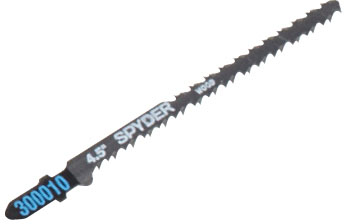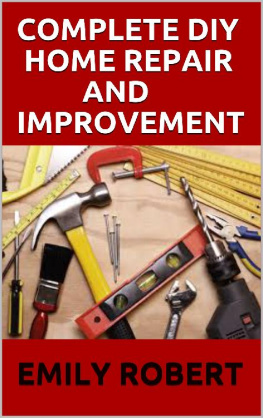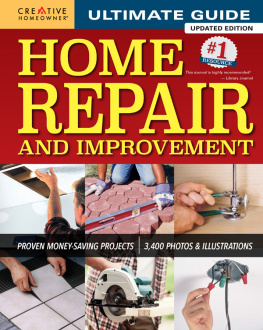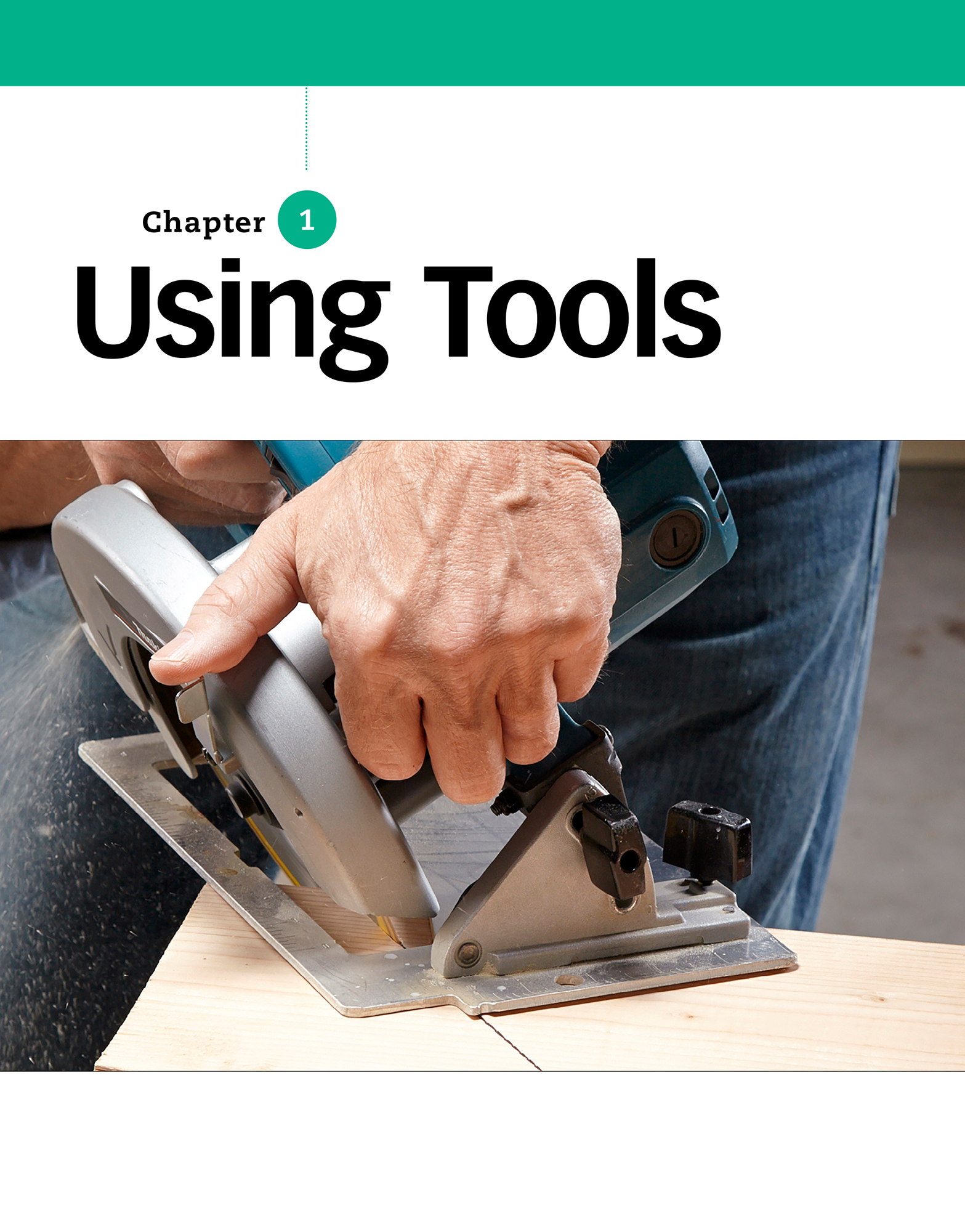A Note to Our Readers
All do-it-yourself activities involve a degree of risk. Skills, materials, tools and site conditions vary widely. Although the editors have made every effort to ensure accuracy, the reader remains responsible for the selection and use of tools, materials and methods. Always obey local codes and laws, follow manufacturer instructions and observe safety precautions.
Pricing
Professional services and supplies can vary widely depending on the market. Those listed are average costs and are just a guide to cost savings.
Safety firstalways!
Tackling home improvement projects and repairs can be endlessly rewarding.
But as most of us know, with the rewards come risks.
The good news is, armed with the right knowledge, tools and procedures, homeowners can minimize risk. As you go about your projects and repairs, stay alert for these hazards:
Aluminum wiring
Aluminum wiring, installed in about 7 million homes between 1965 and 1973, requires special techniques and materials to make safe connections. This wiring is dull gray, not the dull orange characteristic of copper. Hire a licensed electrician certified to work with it. For more information go to cpsc.gov and search for aluminum wiring.
Spontaneous combustion
Rags saturated with oil finishes like Danish oil and linseed oil, and oil-based paints and stains can spontaneously combust if left bunched up. Always dry them outdoors, spread out loosely. When the oil has thoroughly dried, you can safely throw them in the trash.
Vision and hearing protection
Safety glasses or goggles should be worn when-ever youre working on DIY projects that involve chemicals, dust and anything that could shatter or chip off and hit your eye. Sounds louder than 80 decibels (dB) are considered potentially dangerous. Sound levels from a lawn mower can be 90 dB, and shop tools and chain saws can be 90 to 100 dB.
Lead paint
If your home was built before 1979, it may contain lead paint, which is a serious health hazard, especially for children 6 and under. Take pre-cautions when you scrape or remove it. Contact your public health department for detailed safety information or call (800) 424-LEAD (5323) to receive an information pamphlet. Or visit epa.gov/lead.
Buried utilities
A few days before you dig in your yard, have your underground water, gas and electrical lines marked. Just call 811 or go to call811.com.
Smoke and carbon monoxide (CO) alarms
The risk of dying in reported home structure fires is cut in half in homes with working smoke alarms. Test your smoke alarms every month, replace batteries as necessary and replace units that are more than 10 years old. As you make your home more energy-efficient and airtight, existing ducts and chimneys cant always successfully vent combustion gases, including potentially deadly carbon monoxide (CO). Install a UL-listed CO detector, and test your CO and smoke alarms at the same time.
Five-gallon buckets and window covering cords
From 1996 to 1999, 58 children under age 5 drowned in 5-gallon buckets. Always store them upside down and store ones containing liquid with the covers securely snapped.
According to Parents for Window Blind Safety, 599 children have been seriously injured or killed in the United States since 1986 after becoming entangled in looped window treatment cords. For more information, visit pfwbs.org or cpsc.gov.
Working up high
If you have to get up on your roof to do a repair or installation, always install roof brackets and wear a roof harness.
Asbestos
Texture sprayed on ceilings before 1978, adhesives and tiles for vinyl and asphalt floors before 1980, and vermiculite insulation (with gray granules) all may contain asbestos. Other building materials, made between 1940 and 1980, could also contain asbestos. If you suspect that materials youre removing or working around contain asbestos, contact your health department or visit epa.gov/asbestos for information.
For additional information about home safety, visit mysafehome.org. This site offers helpful information about dozens of home safety issues.
Jigsaws
A jigsaw is an essential power tool for beginning DIYers because its less intimidating than its cousin the circular saw and its very versatile. Lots of basic projects require nothing more than a drill and a jigsaw. But DIY veterans need a jigsaw too, no matter how many other tools they own.
A jigsaw excels at cutting curves in lumber and sheet goods of every type, but can also be used to make straight cuts. Compared to a circular saw, its quieter, lighter andbecause the blade moves in a more relaxed up-anddown motionsafer and more user friendly. With the right blade, it can be used to cut metal, plastic pipe and tile.
Things to know:
The narrower the blade, the tighter the curve it can cut. The more teeth per inch (TPI), the smoother the cut.
When making a cut in the center of a board or panel, drill a 3/4-in. starter hole, insert the blade, and then proceed.
For best results, cut slightly outside your cut line. Then you can use a power or hand sander for final shaping.
Get the right jigsaw for you
Some jigsaws have handles; some dont. Many pros like the no-handle barrel-grip style, because feel they have better control with their hands closer to the action. Folks with smaller hands often complain about the barrel being too large to grab.
pro tips!
Pushing as hard as you can on the jigsaw doesnt necessarily make it cut faster; sometimes the exact opposite is true. And pushing too hard into a curve can cause you to veer off your line, burn the material or break a blade. Ease off on the pressure until the jigsaw cuts smoothly with little vibration.
A blade for every occasion
There are a couple of basic things to know about jigsaw blades: The larger the teeth, the more aggressive and rougher the cut. And the narrower the blade, the tighter the turns it can make.
Match the type of blade with the material youre cuttingdont use a wood blade to cut metal. Most manufacturers have taken the guesswork out of blade selectionthe description of the blade and what it does is usually written on the blade itself. Buy a combo pack and youll be ready for most jobs.

FIBER CEMENT

DOUBLE-SIDED

CERAMIC

FLUSH-CUT
Make relief cuts for sharp turns
Theres a limit on how sharp a curve a jigsaw can cut, and that depends on the bladethe narrower the blade, the sharper the turns it can make. If you try to force the blade into a turn tighter than its capable of, youll either veer off your line or break the blade.












